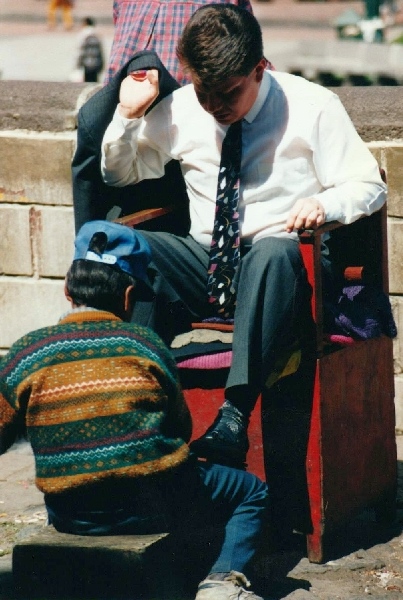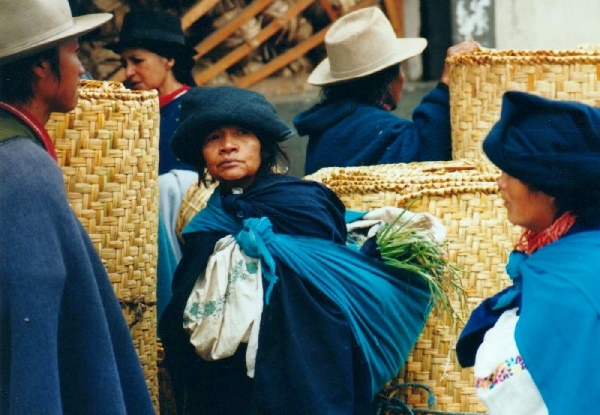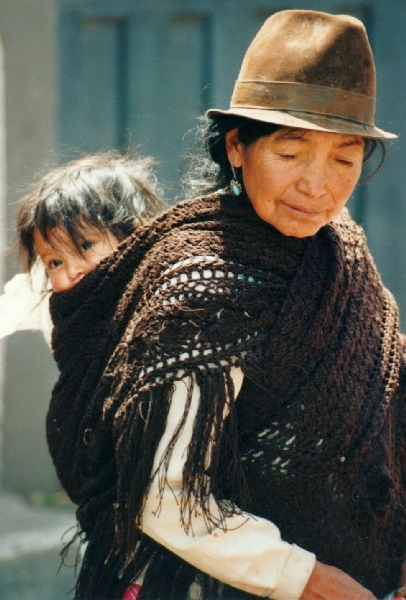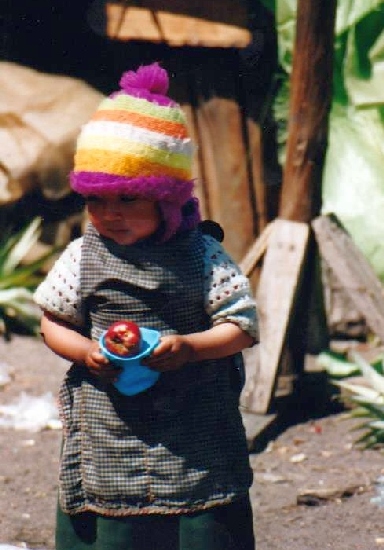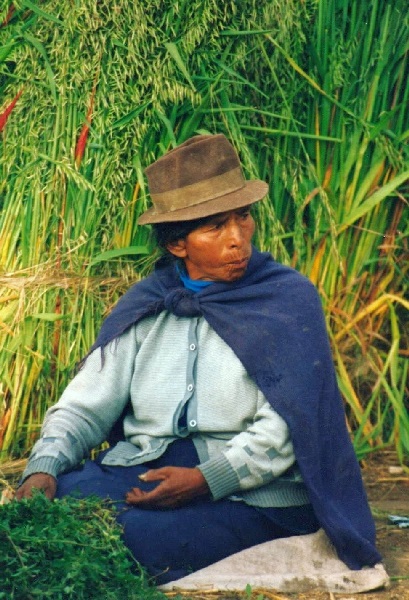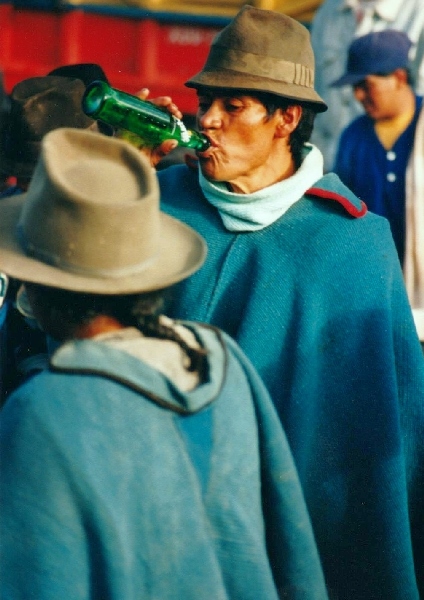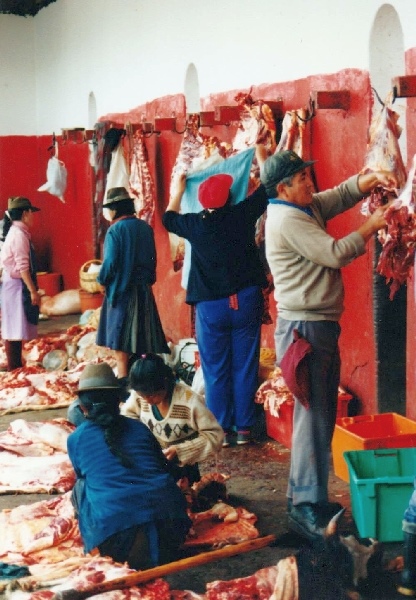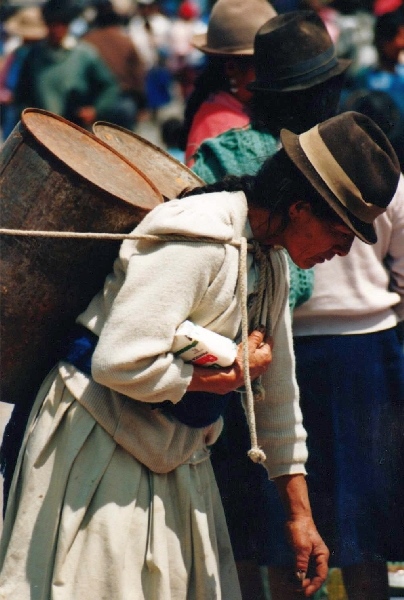World traveler Clown Tom Bolton
Adventure stories & photos

Tom’s adventure travels to Ecuador, South America
Arrival in Quito, Capital of Ecuador
Ecuador was the first country in South America I visited. I arrived in Quito the end of Jan. 1994 to cold and rainy weather. In addition, the smog was terrible and the whole city smelled like sulfur. There were some nice, quaint plazas and old churches in the hilly old town but everything was a bit on the dirty side. I saw a number of street performers on the central Plaza Santa Domingo but didn’t see much I liked. And how profitable it was for them was questionable as the average donation seemed to be 100 Sucre. At the time that was worth around 5 American cents. Street performing for a living in Ecuador didn’t look easy. I’m not sure what the biggest bills were in circulation but when I changed money I was usually given a huge stack of 5000 Sucre notes. One didn’t want to be stuck in some remote place without local currency but changing a couple hundred dollars US meant that one had this huge wad of bills to conceal.
Demonstrations in Quito, Ecuador
There were demonstrations; people protesting recent price increases in Ecuador for gas and bus fares. You never knew when you turned into a street in the old town if a cloud of tear gas or a running mob would greet you. The protests got heavier by the day and there were rumors that Pinochet was coming from Chile soon to advise the government of Ecuador on methods of repressing demonstrators. This turned out not to be true but made the whole atmosphere wildly uncertain with such a strong police presence on the streets. It was ironic that I had chosen Ecuador over Peru because of civil unrest in the later. At least tourists were not the target of either side of the conflict.
Otavalo, Indian market
After a couple of days, I decided to go to the mostly Indian town of Otavalo, 3 hours’ drive from Quito, which has a famous outdoor market. I managed to get there but couldn’t reserve a bus ticket in advance because of strikes, so all travel plans were very tentative. The market, which I got up very early to visit on my second day in Otavalo, was very colorful. One saw plenty of cattle, goats, chickens, etc. in addition to the normal food and wares. Most of the following photos were taken there but as I visited outdoor markets throughout Ecuador, which all look fairly similar, it can be that I have some of the photos from other towns mixed in.

Many old people on market
Quite a few old people seemed to be around the market both buying and selling. I guess few people have pensions in Ecuador so you have to keep working in one form or another until you simply can’t anymore. And the old man here seemed to get around the market pretty well despite being blind. Very noticeable is that Ecuadorians are crazy about ponchos and hats! Some even need 2 hats.

Impoverished laborers
There were many laborers in the markets that transported heavy sacks, which they lashed to their backs with ropes. And many of these human pack mules I saw in Ecuador were virtually midgets and sometimes handicapped. Was sad to see the smallest and weakest of the society having to do the hardest jobs. I have no idea what these guys earned but this was not the only guy literally dressed in rags or maybe his Armani suit was at the cleaners. But obvious in Ecuador was that hard work alone rarely alleviates poverty.
Men having to shop
No idea what might have been discussed below but I love the contrast between how happy the wife looks and how grumpy her husband is; could be any western guy who got dragged to the mall to shop. Somethings in Ecuador are just the same as elsewhere – yet different
Individual tribal dress in Ecuador
Each Indian tribe in Ecuador seemed to have its particular way of dressing but for the most part they stuck to dark or single color garments rather than weaving many bright colors together like I had seen in Guatemala or later in Peru. I had a strange conversation with the daughter of the hotel owner where I stayed in Quito; she said she didn’t like “indios” although she was half Indian herself. Guess being a gringo is an attitude that for many Latinos including in Ecuador means disdaining Indians, maybe as not to be confused with being one of “them”. I think such markets are interesting to photograph not so much because of the different colors but because they give such an overview of the local life. One doesn’t just buy needed things, it’s a chance to see friends and neighbors, catch up with gossip, have a meal out, and see what new things are being offered. And not only is most of Ecuador rural or village life but even a city like Quito retains aspects of this life style. Despite some impressive architecture it’s really just a huge village.
Foreign influences in Ecuador
This is not to say that foreign or “big city” influences didn’t impact the whole of Ecuador. One thing that did catch my eye was the prevalence of Nikes and Reeboks in even out of the way places. This was before the days of cheap Chinese copies everywhere, so I don’t know if they were originals or not. I heard some Latino music but in contrast to my travels in Central America the previous years, I heard mostly American pop music on the radios.
Children unsupervised
I saw plenty of kids in the market. Without childcare one is not surprised to see the women bring the small ones along. Consequentially, even toddlers at times seemed to roam almost at will with little to no supervision. Older kids often tended to help with the selling or shopping. Not sure if I saw more girls than boys doing this because the education of the girls is given less priority or if the boys of poor families would be more likely to be helping dad in the fields. I guess the lack of supervision teaches kids there to be more self-sufficient at an early age. Yet I would find this to be common throughout South America and not unique to Ecuador.
To the coast; Esmeraldes, Atacamas & Muisne
After Otavalo, I got a bus back to Quito and right on to Esmeraldes on the coast. From there I went to Atacamas where a lot of young European and also some Argentinean and Chilean backpackers were hanging at the beach and I could relax and get some sun. The local population was more Latino and many blacks rather than Indian. Such a difference in climate, altitude and culture made it seem like a whole different country. Unfortunately, carnival was coming up and there was a lot of rather aggressive water throwing. The beach was nice but I got a bit bored and heard that for carnival all of the rooms would be booked out. Thus I made a day trip down the coast to Muisne. This was a mistake because it was full of garbage and lots of pesky sellers preceding the carnival mobs. Thus, I lightened my load by giving away my suntan lotion and bug spray to other backpackers and headed back up into the mountains via Esmeraldes and Quito. I had hardly taken photos in Quito because of the rain and didn’t take any at the coast. Pictures of gringos on the beach would have seemed more like a holiday than an adventure travel worth documenting.
Highlands redux, Baños, Ambato & Latacunga
Spent a couple of days in the capital changing money, checking the post office for letters, calling home, buying film for my camera etc. and made a day-trip to Sangolqui village to see their market. Then headed south to Baños, which was one of the nicest but most touristy towns in Ecuador. There were not only some nice waterfalls and climbs outside of Baños but it became a base for day-trips and short excursions to other nearby towns. A number of Swedes had settled here and opened quite dull but expensive restaurants.
A new place, cafe Hood was very popular amongst the backpackers as it had a limited menu but good prices and vegetarian food. The owner was a Buddhist guy from Michigan who had been a puppeteer in San Francisco who was married to an Ecuadorian woman. He commented that he making more money with his cafe, where he also sold postcards made from his own travel photos, than he had as a performer in the US. To this day, I still have this place as an example to what I might aspire to when I give up performing. Maybe a little guesthouse for backpackers in some warm country with a cafe where I can also display my photos and sell prints and postcards. Seemed a number of travelers came through and decided to stay awhile, like the son of the famous pantomime Marcel Marceau, who had recently been there for 8 months teaching yoga.
I don’t have a lot of photos from Baños itself as most of the architecture was nothing dramatic. The basilica in the photos was by the main square and painted in strange colors with the black and white detailing. Since then it’s been repainted in a much more appealing style. Otherwise, I seemed to have mostly taken photos of people on the street. The photos from a market here were probably in Sangolqui rather than Baños tiself.

Saquisili livestock market
From Latacunga I made a day trip to the market in Saquisili. Was more colorful than the one in Otavalo and had more large animals like lamas and some colorful cowboys which herded around the horses and cows. I think it was a big social thing to put on their best outfits and prance around. Like an urban dweller showing off his sleek car, here one would have a great looking horse. Although the cowboys were male, just as often it would be a woman selling the cattle and horses. Same work, just less pretension involved. There was a section where the normal market offerings rather than just livestock were on display.
Zambagua, Ecuador
From Latacunga I did a day trip to Zambagua, which was a nice village, nestled high in picturesque mountains, which just fit to my idea of terraced mountaintops in the Andes. One thing I noticed there for not the first time in Ecuador there were men playing volleyball. Not bad to have fun but who would have thought they had the time during the week. I’m not even positive these first 2 photos were in Zambagua rather than by Latacunga but the aesthetic simplicity of the architecture often had its charm in such Ecuadorian communities.I took some pictures in Zambagua of a typical scene: a celebration with a marching band in the street. I was never sure if they were weddings or funerals since neither a wedding dress nor coffins were evident. But they were always loud, excited events and ended up at a church.
Ambato & Guaranda
Leaving Latacumba, I took a bus to Ambato where I had to stay the night at a dive near the bus station to catch a morning bus on to Guaranda. Was a bit of excitement as the passengers were outraged at more recent fare hikes. Normally one wouldn’t concern themselves over gringos getting over-charged but the locals protested in solidarity when they took what they deemed to be too much of my money. Guaranda, Ecuador was a pretty place but I wasn’t used to the altitude. We passed close to the highest peak in Ecuador. Read that it should be the farthest point on earth from the equator, the bulge of the equator more than making up for the additional altitude of Everest. The area was amazing though, such intense cultivation on such steep, high slopes but I found the people rather unfriendly when I tried to take photos. The hotel I had was loud with guys yelling around till all hours of the night both in the street and in the room next to me. To top it off I must have eaten something bad because I came down with lots of stinky gas but luckily no diarrhea. The sky was clear for a while in the early morning given a nice view of the peaks but I was happy to return to Baños to hang out and relax a few days before going to Cuenca.
Cuenca, Ecuador
It was pouring rain on the way to Cuenca and we passed villages, which looked half flooded. The city itself looked nice except for the abundance of mud. On the one hand, I ran into a couple of very shady characters in Cuenca, on the other, there was a very large police presence and I saw one group of police with Uzis kicking what I assume was a thief. In Cuenca I went to the movies, seeing a martial arts double feature but basically felt bored. Anyway, I took a lot of photos in Cuenca, again in markets. The first images are of the Cathedral of the Immaculate Conception with its beautiful 3 blue domes. There is actually another older cathedral across from it on the other side. A notable church was the San Francisco church on the similarly named plaza. I then decided to travel on towards Peru. I hadn’t originally planned to go but kept meeting travelers coming from there saying how great it was and that the Shining Path insurgency had been brought under control and tourists were now welcome there. I got frustrated that I wasted lots of time trying to get some Peruvian money, often after waiting in a line having been told it would be possible. Seems they neither wanted to change travelers’ checks nor sell Peruvian money, something to do with the strained relationship between the 2 countries which contested the demarcation of some of their shared border.
Typical market scenes in Ecuador
Like all markets in Ecuador, there were multitudes of people in Cuenca shopping, eating etc. and not just the animals. There were plenty of bananas and plantains to be found throughout the country, which was always a stark reminder while high in the Andes that Ecuador also has a tropical to subtropical coast.
Loja & Macará
I took a bus to Loja; weather was a bit drier and had some nice views through the clouds. The mountains seemed to get steep the further south we traveled. Just stayed a night in Loja which seemed a quiet place before getting an early bus to Macará which included going through 4 passport controls while still in Ecuador. Then passing the border into Peru itself was mostly uneventful although I had to push them to give me a 60 instead of a 30 days visa.
Transportation in the Andes
This was an often seen form of transportation in the Andes. Trucks would drop off a load somewhere and rather than go back empty, they would fill up with passengers. Not very comfortable but in many places there wasn’t any other way to get around. Later on this trip, while in Peru, I went off with some young locals staying at my hotel to see some remote ruin in the mountains. It was too far to walk back to the village and we hitched a ride on such a truck. Only it was full of cattle and we sat balanced on some boards above the animals. The driver was drunk or buzzed on coca leaves and swerved all over the road and I thought we might go over the side of the mountain. The girls were screaming in terror that they would fall down amongst the animals and get trampled. The driver finally had to stop when one of the animals fell out of the back of the vehicle and we wisely decided to get out! We then hitched a ride in a government dump truck. Was safe but bumpy as hell. There were 2 injured locals on stretchers that were being taken to the next hospital and one moaned and cried out with every major bump that one thought he might be dying. I think we all had frazzled nerves by the time we arrived. When one had a real bus, it was often packed with grain bags, goats and chickens both inside and on the roof, so only marginally better.
So, those were just a few tales from my many travels over the last thirty and something years. I hope you've enjoyed another side of a traveling clown! If you want, write me an email or better yet, book my show or set a link to this website or just state me as the beneficiary of your will!
To book or see more information about Tom's clown show and entertainment, visit one or both of his clown websites:
Clown Stuttgart www.clowntombolton.com
Clown juggler Stuttgart, Gremany www.clown-event.de










